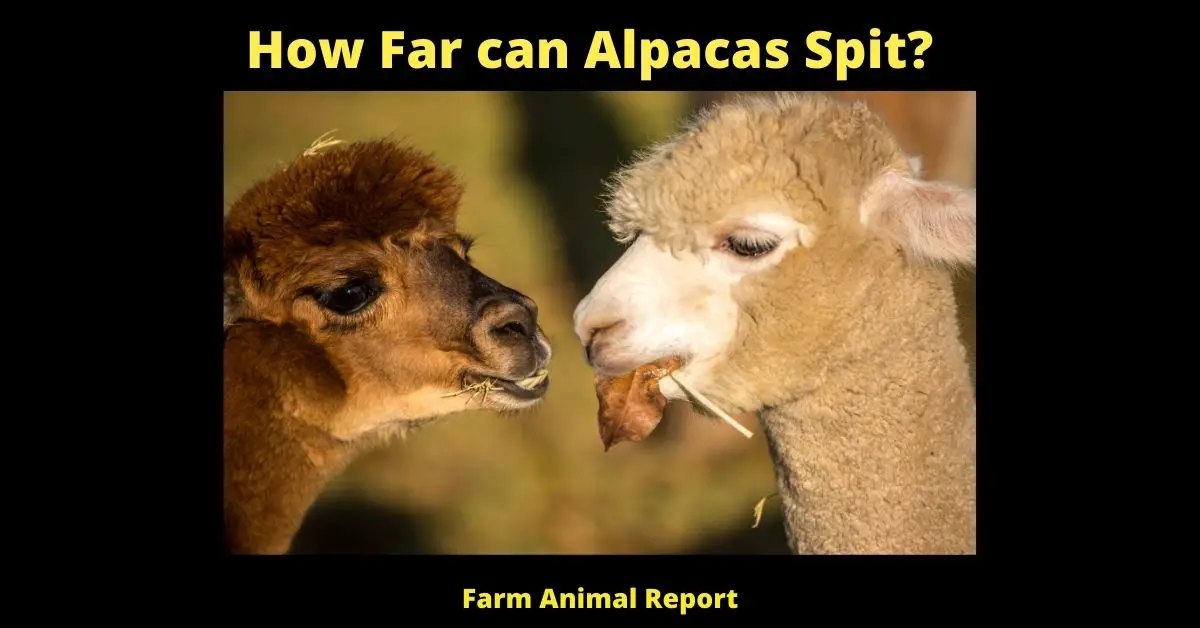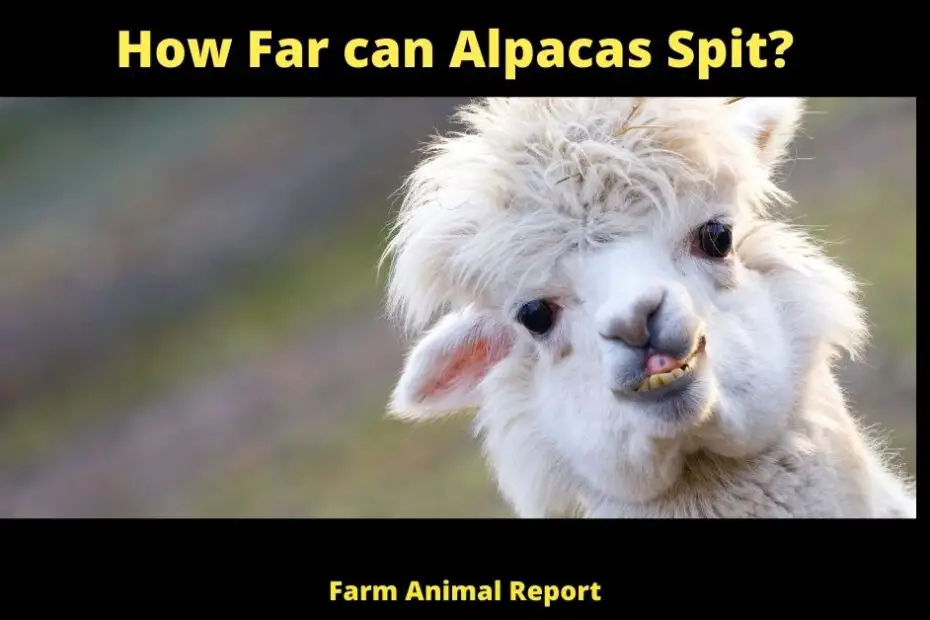Can Alpaca Spit Blind You – As a General Rule Alpacas can spit approximately 10 feet. The average is 5 feet. Alpacas will spit if annoyed, as a show of Dominance, to establish a pecking order, or if threatened by a predator
Can Alpaca Spit Blind You | How Far can Alpacas Spit?
How Far can Alpacas Spit? – Alpacas are docile animals, yet they will not hesitate to spit at you if they feel threatened. There is no set distance that an alpaca can spit, but it’s usually around 10 feet, while the average person can spit about 5 feet. How Far can Alpacas Spit?
In stress or to show dominance, the Alpacas may even hiss or even kick at their owners until their burden is lessened.
Why Alpacas Spit | Llama Spit
- Not Interested in Male Advances
- Show of Dominance
- Establish Pecking Order
- Being Disturbed while eating
- Threatened By a Predator
Check Out Amazon’s Educational Resources for Raising Alpacas
Alpacas spit for several reasons. The most common reasons are given below.
- Alpacas spit to communicate with one another
When Alpacas want to communicate with one another, they usually spit. The most common do spitting when they are in distress, fearful, or meaning to show dominance.
- Female Alpaca spit when she is not interested in mating
An adult female uses spitting to communicate with a male that she is uninterested in his approaches, and both genders do it to keep competition away from food sources. Spitting can also be used to scare an adversary away from a location.

female alpaca – llama spit
- To ward off predators
Spit has a range of uses, such as marking territory or warding off predators and pests.
A few Alpacas are simply more irritable than others, and they will spit even when they are not provoked. However, the majority of them generally offer ample notice before unleashing their whole arsenal.
- Spitting defines the social group
Alpacas are herd animals, and their spitting helps define the social hierarchy of the group – How Far can an Alpaca Spit?
Fact: It’s recommended not to pet an alpaca on its head because they may think you’re trying to dominate them and will retaliate by spitting at you
18 ways Alpaca Farmers make Money
What is Alpaca Spit Made of | Farm
How Far can Alpacas Spit? “Spit” is a euphemistic term. However, alpacas are known to bring up acidic stomach contents (usually consisting of a green, grassy mix) and project these onto their selected targets. The majority of the time, an alpaca will spit at another alpaca, but it will occasionally spit at a human as well.
Spitting causes “sour mouth” in alpacas, which is a condition that can be fatal. A gaping mouth and a loose-hanging lower lip are the hallmarks of a sour mouth condition. This is generated by the stomach acids and the disagreeable taste of the contents when they travel into the mouth.
How do Alpacas spit? Process of Alpaca spitting
Alpacas raise their chin, and they’ll flatten their ears back, and they may first threaten that way. Then, if the animal/human towards whom they are targeting their behavior doesn’t notice it, they will blow some air and saliva into the air to alert it. A little “puffeth” noise is produced as well.
If the offended party doesn’t take the warning and back off, the llama or Alpaca will vomit its stomach contents and spit at the offending individual. Fortunately for the animals, their triumphant moment is short-lived because the gastrointestinal muck isn’t nice for them, either.
Other animals or humans are unable to handle the taste of it at all! They’ll literally sit there with their jaws wide and their ears at half-mast as if they’re trying to spit on you. It’s actually rather amusing! So their mouth is hanging open, the green stuff is dripping from it, and they simply appear to have had their mouth cleaned out with soap.
After taking spit, some people may roam around, looking for something like a breath mint or a nice leaf, simply to attempt to get the taste out of their mouth, while others will sit and watch. “Ah, why did I do that,” they’ll think for a few minutes as they ponder their actions.

But remember, it is a fact that the majority of Alpacas do not spit on humans. Keep eye contact with them, but avoid making them feel threatened if their ears are pushed back, and they’re glaring at you.
Why do Alpacas Spit in your Face? Or Does Alpaca Spit in Eye?
Alpaca can spit directly on your face/eyes because they think it is the most vulnerable part. They only spit on your face if you are continuously staring at them; they take your stare as a threat and spit.
But Alpacas can accept another human as part of their family. If you come in close contact, they may like you like their own herd. As part of that relationship, and considering how they behave with each other, kicking, spitting, and neck wrestling can also be directed toward humans.
Is Alpaca Spit Dangerous? Or Does Alpaca Spit Hurt?
Alpaca spit is not dangerous, nor does it hurt you, but it’s unpleasant. As discussed above, Alpacas spit is made up of stomach acid contents having gastric juice, which is unpleasant and stinky.
Alpacas have three compartments in their stomachs, each of which contains gastric acid juice in different concentrations. They will regurgitate fluids from one compartment (the region that contains the not-so-vile stomach juice) and utilize it first before utilizing the gastric juice from the other compartments, which tends to have a very strong and disgusting flavor compared to the first one.
The Alpaca chews its meal several times before swallowing it, and it frequently vomits the food back up after doing so. The lump in their neck that is noticeable as they chew may have alerted you to the fact that they were doing so.
Their spit does not include large bits of food due to their particular chewing mechanism. Instead, the meal is generally totally liquefied. Therefore, if an alpaca spits in your face, it will not damage you, but it will be an unpleasant experience for you.
Can Alpaca Spit Blind You?
No, Alpaca spit can never blind you. But you must wash your face immediately when Alpaca spit at you. It can save you from zoonotic diseases and the unpleasant odor of Alpaca’s stomach contents.
Do Alpacas Spit Acid?
In general, no, but technically yes. They spit slightly acidic content of the stomach. But that acidic content does not have a very low pH, which can harm human skin. So, Alpaca spit does not actually act as a harmful acid.
What Happens if you Spit Back at a Llama? Or What happens if you Spit at an Alpaca?
Nothing happens. In fact, your spit cannot reach them as their spitting range is 10 feet and a human’s spitting range is 5 feet. So first of all our spit never reach them. Second, we must understand that spitting is their natural way to communicate (whether positive or negative). So try to be calm and wash your face instead of spitting back on them.

Do Alpacas Spit more than Llamas?
No Alpacas can not spit more than Llamas. Llamas can spit more than Alpacas or any other related cousins, such as vicunas and guanacos. This is due to their natural behavior and temperament. Llamas are considered a little bit clever and naughty.
So, Alpacas are nicer and considerably more docile than llamas; they are less likely to spit on humans when they are not threatened.
Is it true that all alpacas spit?
Not all alpacas spit, but they are all capable of doing so if they choose to. Because it leaves an unpleasant taste in their mouth, spitting is normally reserved as a last resort defense tactic for alpacas. It is also possible that alpacas would stand with their lips hanging open after spitting to let the spit escape. Some people even go to the extent of attempting to discover food that would assist them in getting the taste out of their mouths.
Do Baby Alpacas Spit?
Yes, baby Alpacas are capable of spitting; however, they may be taught to decrease the habit and avoid spitting on their carers and other humans.
Do alpacas have a biting habit?
As a peaceful species, alpacas do not bite humans and are not aggressive towards them.
However, spitting is a common way for them to show displeasure and communicate with one another.
Males and herdsires in good health can be violent, and a male alpaca fight can result in serious harm. Some alpaca breeders remove the fighting teeth of a fully grown male in order to prevent this from occurring.
Are alpacas intelligent animals?
Alpacas are intelligent animals that are easy to teach. They may be taught orders, hand gestures, and other skills as well.
Are llamas or alpacas friendly?
Even though the Alpaca and the llama are related, the Alpaca is far more friendly and docile. As a result, the Alpaca is believed to be more friendly than the llama.
Is it possible for alpacas and dogs to get along?
Both yes and no. In situations when dogs, such as Great Pyrenees, are used as livestock guard dogs and reside within the alpaca barn and pasture, alpacas are recognized for coexisting well with their canine companions. In other instances, alpacas might be terrified of dogs and respond by spitting or leaping in their direction.
Is it possible for alpacas to die from loneliness?
Alpacas are herd animals, and as such, they require the company of other alpacas to socialize and feel secure. When an individual alpaca is under persistent stress and unhappiness, its health suffers and may finally succumb to the effects of the stress.
A herd of alpacas should contain a minimum of three alpacas to be considered healthy. This enables one Alpaca to be designated as the alpha alpaca, with the rest alpacas serving as the supporting herd around him.
Is it possible to have alpacas as pets?
Alpacas are gentle, gregarious creatures who are intelligent, trainable, and a little eccentric. Because of these characteristics, as well as their general teddy bear look, they make terrific companions.
It is also vital to note that they are regarded as livestock and that they belong to a herd of creatures. As a result, to thrive, they require an agricultural setting and must coexist with other alpacas.
Alpacas cannot be kept as solitary pets in apartments, cities, or subdivisions for health and safety reasons. Before acquiring any alpacas, you should research the zoning regulations in your area.
When are alpacas sheared, and how often?
Alpacas are shorn once or twice a year, in the spring/autumn. The month of May is the best time to shear since it allows us to tackle both the chilly nights of spring and the scorching days of summer.
Shearing alpacas is often done by professional teams that tour the country, shearing animals at various farms along the way.
Do alpacas have a foul odor?
Alpacas do not have a foul odor. This is because they are clean creatures that prefer to urinate and defecate in a community litter box rather than on the ground. If an alpaca does not have access to a litter box, he or she will automatically construct and utilize one.
What is the total number of alpacas in the world?
According to the organization, the Alpaca Owners Association (AOA) has more than 200,000 registered alpacas in 19 countries. According to the statistics, Canada, the United States, and Australia have the biggest number of registered alpacas; however, this information will be deceptive on its own.
South America is home to over four million alpacas, with Peru having the world’s highest alpaca population at over one million. Bolivia, Chile, Ecuador, the United States, Australia, England, and Canada are just a few nations that produce large quantities of Alpaca.
What is the population of alpacas in the United States?
The first alpacas were brought to the United States in 1984. The American Alpaca Association (AOA) has registered over 193,000 alpacas in the United States, while the 2017 Census of Agriculture reported that there were over 122,000 alpacas in the United States. Although both of these figures are accurate, neither one represents the real number of alpacas in the United States.
Peru’s Ministry of Agriculture and Irrigation (MINAGRI) recently stated that the country has approximately 3.85 million alpacas, accounting for approximately 87 percent of the world’s alpaca population. According to the Ministry of Agriculture and Irrigation (MINAGRI),
Peru is the largest alpaca fiber producer. Peruvian alpaca fiber output is over 4,510 tons per year, and the country’s alpaca fiber exports were more than US$ 70 million as of the end of 2017.
The Ministry of Foreign Tourism and Trade reported that the country’s alpaca exports climbed by more than 110 percent in 2016 compared to the previous year, with an increase in the average export price per kilogram of Alpaca of more than 15 percent on average.
Peru continues to be the world’s leading producer and exporter of alpaca fiber, with the majority of its exports going to China and Italy. Peruvian alpaca fiber exports are mostly destined for China and Italy.
Interesting Facts About Alpacas
- An alpaca is a South American mammal. It was domesticated around 2000 years ago. Its look is similar to that of a llama.
- In the Andes, alpacas are gregarious animals that are kept in herds that graze on level heights between 3,600m and 5,200m above sea level in southern Ecuador, Peru, northern Bolivia, and northeast Chile.
- It is estimated that alpacas were domesticated by the Incas more than 6000 years ago. Alpacas are primarily raised for their silky wool, which is the most adaptable fiber found in nature, and they are shorn once a year for this purpose. Alpaca fiber is exceptionally soft and fine, and it is used to make knitted and woven goods that are comparable to wool in texture and appearance. However, it is hypoallergenic due to the absence of lanolin in the fiber and being flame-resistant and water-resistant. Characterized as being stronger than mohair, finer than cashmere, smoother than silk, and softer than cotton, Alpaca is also described as being more insulating than goose down and better at regulating body temperature and breathability than thermal knits.
- Blankets, gloves, caps, sweaters, scarves, a broad range of textiles, and shawls are all created from alpaca fiber in South America, while sweaters, socks, jackets, and beds are made from alpaca fiber in other areas of the world. There are more than 22-25 natural colors, and hundreds of tints available in the fiber, ranging from white to light rose grey to dark fawn.
- A typical shearing season for alpacas occurs once a year in the spring. Each alpaca shears generates roughly five to ten pounds (2.2–4.5 kg) of fiber every shearing (or shearing session). As much as 50 to 90 ounces (1420–2550 grams) of first-quality fiber and 50 to 100 ounces (1420–2840 grams) of second-and third-quality fiber may be produced by an adult alpaca, depending on its size. Our alpaca fleeces are available for purchase at our farm shop!
- Alpacas make several different noises:
- A high-pitched screaming sound can be heard when they are in danger. When some breeds get agitated, they are known to produce a “wark” noise—alpacas “cluck” or “click” to indicate friendly or subservient behavior. Depending on the species, the sound is thought to be produced by suction on the soft palate or maybe in the nasal cavity.
- Alpacas generally produce a humming sound; however individual variations exist. Hums are frequently used as comfort noises, letting the other alpacas know they are present and pleased with their surroundings. The humming might have a variety of inflections and connotations.
- When males battle, they produce a warbling, bird-like cry, which is said to be meant to frighten their opponents into submission.
- Alpacas consume far less than most other animals of their size, requiring about 1-2 percent of their body weight in food every day. They usually consume hay or grasses, but they may eat other plants as well (for example, certain leaves), and they can chew on practically anything if given a chance (e.g., empty bottle). Farmers will feed their domestic alpacas grain regularly in order to give them selenium and other essential vitamins. The top of the plant is snipped off by alpacas when they consume grass, unlike other animals who pull the grass up by the root when they eat grass. They have earned a reputation as excellent lawnmowers as a result of this.
- As pseudo ruminants, alpacas have a three-chambered stomach, similar to that of other camelids (as discussed above). When paired with chewing cud, this three-chambered mechanism provides for the most efficient absorption of nutrients from low-quality fodder sources.
Final Thoughts
Alpacas are well-known for being quirky, long-necked creatures that are acknowledged for spitting and humming at random intervals. They’re commonly mistaken for llamas, which are closely related to the Alpaca in both appearance and behavior.
Both animals are part of the camelid family, including animals such as camels, guanacos, and vicunas, among other species. Since their introduction to the United States in the late nineteenth century, they have been on exhibit in zoos as curiosities, which have remained until the early twentieth century.
They are just as easy to feed as other grazing animals, and they use far less grain than other grazing animals. Alpacas are good grazers if there is enough grass available for them to use. It is possible to utilize pastured hay as a replacement for pasture in colder climates when pasture is not readily available during the winter months.
Alpacas, despite their great size, consume a surprisingly tiny quantity of food for their size. Alpaca can thrive on one or two flakes of hay each day, as well as a small quantity of grazing pasture if it is grown to adulthood.
If you want to attain the best grazing results possible, split your pasture into many tiny zones and rotate your grazing animals between them so that each animal has the opportunity to recuperate and grow.
The number of animals that will be grazing on each grazing lot will decide the size of each grazing lot. The same as with other animals, llamas should always have access to fresh drinking water consistently.
Alpacas are generally considered to be extremely resilient animals. Even though they are less prone to sickness than most cattle, they will still require regular veterinary care and attention. Your Alpaca’s feet need to be cleaned and trimmed on a regular basis in order to keep him looking his best and avoid him becoming injured in the future.
To reduce the danger of having enterotoxaemia in the future, they should also obtain tetanus immunizations as well as vitamin C and D supplements, among other things.
If you live in a very harsh climate, your veterinarian may advise you to get your animals immunized more frequently to keep them in good condition. Inquire with your veterinarian for advice on supplements.


